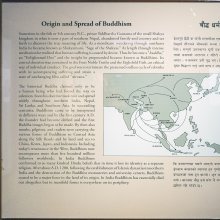Nepala, Nepāla: 26 definitions
Introduction:
Nepala means something in Buddhism, Pali, Hinduism, Sanskrit, Jainism, Prakrit, the history of ancient India, Marathi, Hindi, biology. If you want to know the exact meaning, history, etymology or English translation of this term then check out the descriptions on this page. Add your comment or reference to a book if you want to contribute to this summary article.
Images (photo gallery)
In Hinduism
Purana and Itihasa (epic history)
Source: archive.org: Puranic EncyclopediaNepāla (नेपाल).—The kingdom of Nepal on the boundaries of the Himālayas has been famous from Purāṇic times. It is the only 'Hindu' State in the world. Karṇa, during his triumphal tour, had conquered Nepal also. (Vana Parva, Chapter 254, Verse 7).
Source: Cologne Digital Sanskrit Dictionaries: The Purana IndexNepāla (नेपाल).—(c)—sacred to Lalitā and hence to be included in the cakra.*
- * Brahmāṇḍa-purāṇa IV. 44. 93.

The Purana (पुराण, purāṇas) refers to Sanskrit literature preserving ancient India’s vast cultural history, including historical legends, religious ceremonies, various arts and sciences. The eighteen mahapuranas total over 400,000 shlokas (metrical couplets) and date to at least several centuries BCE.
Shaivism (Shaiva philosophy)
Source: Wisdom Library: ŚaivismNepāla (नेपाल) is a Sanskrit word referring to one of the sixty-eight places hosting a svāyambhuvaliṅga, one of the most sacred of liṅgas according to the Śaivāgamas. The presiding deity residing over the liṅga in this place (Nepāla) is named Paśupati. The list of sixty-eight svāyambhuvaliṅgas is found in the commentary of the Jirṇoddhāra-daśaka by Nigamajñānadeva. The word liṅga refers to a symbol used in the worship of Śiva and is used thoughout Śaiva literature, such as the sacred Āgamas.

Shaiva (शैव, śaiva) or Shaivism (śaivism) represents a tradition of Hinduism worshiping Shiva as the supreme being. Closely related to Shaktism, Shaiva literature includes a range of scriptures, including Tantras, while the root of this tradition may be traced back to the ancient Vedas.
Natyashastra (theatrics and dramaturgy)
Source: Wisdom Library: Nāṭya-śāstraNepāla (नेपाल) is the name of a country pertaining to the Oḍramāgadhī local usage (pravṛtti) according to the Nāṭyaśāstra chapter 14. It is also known by the name Nepālaka. These pravṛttis provide information regarding costumes, languages, and manners in different countries of the world. It is mentioned that this local usage (adopted by these countries) depends on the verbal style (bhāratī) and the graceful style (kaiśikī).

Natyashastra (नाट्यशास्त्र, nāṭyaśāstra) refers to both the ancient Indian tradition (shastra) of performing arts, (natya—theatrics, drama, dance, music), as well as the name of a Sanskrit work dealing with these subjects. It also teaches the rules for composing Dramatic plays (nataka), construction and performance of Theater, and Poetic works (kavya).
Shaktism (Shakta philosophy)
Source: Google Books: ManthanabhairavatantramNepāla (नेपाल) is the name of a sacred place classified as a Upapīṭha, according to the Manthānabhairavatantra, a vast sprawling work that belongs to a corpus of Tantric texts concerned with the worship of the goddess Kubjikā.—The eight seats are the main group of eight groups [i.e., Nepāla] of eight types of sacred sites. The figure sixty-four is a common ideal number as it is often configured into eight groups of eight.
Source: archive.org: Personal and geographical names in the Gupta inscriptions (shaktism)Nepāla (नेपाल).—The Śaktisaṅgama-tantra describes the country of Nepāla as placed between Jaṭeśvara and Yoginī. Sircar equates Yoginīpura with Delhi and Jaṭeśvara with Jalpeśvara, the famous Śiva of the Jalpaiguri district in North Bengal.

Shakta (शाक्त, śākta) or Shaktism (śāktism) represents a tradition of Hinduism where the Goddess (Devi) is revered and worshipped. Shakta literature includes a range of scriptures, including various Agamas and Tantras, although its roots may be traced back to the Vedas.
Kavya (poetry)
Source: Shodhganga: The Kavyamimamsa of RajasekharaNepāla (नेपाल) is the name a locality mentioned in Rājaśekhara’s 10th-century Kāvyamīmāṃsā.—It is modern Nepal. In the Kāvyamīmāṃsā of Rājaśekhara included it in the list of the mountains, which is the country of the eastern India.

Kavya (काव्य, kavya) refers to Sanskrit poetry, a popular ancient Indian tradition of literature. There have been many Sanskrit poets over the ages, hailing from ancient India and beyond. This topic includes mahakavya, or ‘epic poetry’ and natya, or ‘dramatic poetry’.
Jyotisha (astronomy and astrology)
Source: Wisdom Library: Brihat Samhita by VarahamihiraNepāla (नेपाल) refers to a kingdom or tribe of people, according to the Bṛhatsaṃhitā (chapter 4), an encyclopedic Sanskrit work written by Varāhamihira mainly focusing on the science of ancient Indian astronomy astronomy (Jyotiṣa).—Accordingly, “If Venus should be eclipsed by the lunar disc the people of Magadha, the Yavanas, the Mlecchas, men of Pulinda (a barbarous tribe), the Nepālīs [i.e., nepāla], the Bhṛṅgīs and the Mārwārīs (Marus), the men of Kaccha and of Surat, the Madras, the Pāñcālas, the Kaikayas, the Kulūtakas, the Cannibalas (Pūruṣādas) and the men of Uśīnara (Gāndhāra) will suffer miseries for seven months”.

Jyotisha (ज्योतिष, jyotiṣa or jyotish) refers to ‘astronomy’ or “Vedic astrology” and represents the fifth of the six Vedangas (additional sciences to be studied along with the Vedas). Jyotisha concerns itself with the study and prediction of the movements of celestial bodies, in order to calculate the auspicious time for rituals and ceremonies.
General definition (in Hinduism)
Source: archive.org: Indian Historical Quarterly Vol. 7Nepāla (नेपाल) is the name of a country classified as both Hādi and Kādi (two types of Tantrik division), according to the 13th century Sammoha-tantra (fol. 7).—There are ample evidences to prove that the zone of heterodox Tantras went far beyond the natural limits of India. [...] The zones in the Sammoha-tantra [viz., Nepāla] are here fixed according to two different Tantrik modes, known as Kādi and Hādi.
In Buddhism
Mahayana (major branch of Buddhism)
Source: archive.org: Bulletin of the French School of the Far East (volume 5)Nepāla (नेपाल) (in Chinese: Ni-p'o-lo) is the name of an ancient kingdom associated with Kṛttikā or Kṛttikānakṣatra, as mentioned in chapter 18 of the Candragarbha: the 55th section of the Mahāsaṃnipāta-sūtra, a large compilation of Sūtras (texts) in Mahāyāna Buddhism partly available in Sanskrit, Tibetan and Chinese.—Chapter 18 deals with geographical astrology and, in conversation with Brahmarāja and others, Buddha explains how he entrusts the Nakṣatras [e.g., Kṛttikā] with a group of kingdoms [e.g., Nepāla] for the sake of protection and prosperity.

Mahayana (महायान, mahāyāna) is a major branch of Buddhism focusing on the path of a Bodhisattva (spiritual aspirants/ enlightened beings). Extant literature is vast and primarely composed in the Sanskrit language. There are many sūtras of which some of the earliest are the various Prajñāpāramitā sūtras.
Tibetan Buddhism (Vajrayana or tantric Buddhism)
Source: OSU Press: Cakrasamvara SamadhiNepāla (नेपाल) is the name of a country, according to the Guru Mandala Worship (maṇḍalārcana) ritual often performed in combination with the Cakrasaṃvara Samādhi, which refers to the primary pūjā and sādhanā practice of Newah Mahāyāna-Vajrayāna Buddhists in Nepal.—Accordingly, “[...] On the Bharata continent, in northern Pāñcāla, at the feet of the Himalayas, In the land of Vāsuki, the seat of Upachandoha, in the holy land Āryāvarta, In the home of Karkoṭaka king of serpents, In the great lake Nāgavāsa, Site of Śrī Svayambhū Caitya, inhabited by Śrī Guyeśvarī Prajñāpāramita, In the land of the Nepal mandala (nepāla-maṇḍala), in the form of the Śrī Saṃvara mandala, In the same land of Sudurjayā, [...]”.,

Tibetan Buddhism includes schools such as Nyingma, Kadampa, Kagyu and Gelug. Their primary canon of literature is divided in two broad categories: The Kangyur, which consists of Buddha’s words, and the Tengyur, which includes commentaries from various sources. Esotericism and tantra techniques (vajrayāna) are collected indepently.
In Jainism
General definition (in Jainism)
Source: archive.org: TrisastisalakapurusacaritraNepāla (नेपाल) is the name of an ancient kingdom, according to chapter 4.2 [vāsupūjya-caritra] of Hemacandra’s 11th century Triṣaṣṭiśalākāpuruṣacaritra: an ancient Sanskrit epic poem narrating the history and legends of sixty-three illustrious persons in Jainism.
Accordingly, as Vasupūjya and Jayā spoke to Vāsupūjya:—“All the existing kings, among men and the Vidyādharas, who are of good family, capable, heroic, wealthy, famous, possessing the fourfold army, known for guarding their subjects, free from blemish, faithful to engagements, always devoted to dharma, in Madhyadeśa, Vatsadeśa, [... the Nepālas, ...] these now, son, beg us constantly through messengers, who are sent bearing valuable gifts, to give their daughters to you. [...]”.

Jainism is an Indian religion of Dharma whose doctrine revolves around harmlessness (ahimsa) towards every living being. The two major branches (Digambara and Svetambara) of Jainism stimulate self-control (or, shramana, ‘self-reliance’) and spiritual development through a path of peace for the soul to progess to the ultimate goal.
India history and geography
Source: archive.org: Personal and geographical names in the Gupta inscriptionsNepāla (नेपाल) is a place-name without suffix and is mentioned in the Gupta inscription No. 1. The Gupta empire (r. 3rd-century CE), founded by Śrī Gupta, covered much of ancient India and embraced the Dharmic religions such as Hinduism, Buddhism and Jainism. Nepāla is mentioned as one of the border states which accepted the subordination of Samudragupta. The former name of Nepāla was Śleṣmātakavana.
Some take Nepāla to refer to Tippera which is doubtful. The city is said to have been founded by Ne ṛṣi who performed his religious services at the junction of the Bāgmatī and Kesāvatī and who also ruled over the country. The Nepāla valley originally contained a lake called Nāga Bāsa or Kālihrada, in which lived Nāga Karkoṭaka. It was fourteen miles in length and four miles in breadth.
Nepāla was a buffer state in the 7th century A.D. In the 8th century A.D. she shook of its domination by Tibet. According to the Deopara inscription, Nānyadeva, the ruler of Nepāla, is said to have been defeated and imprisoned with many other princes by Vijayasena, about the middle of the 12th century A.D.
Source: What is India: Inscriptions of the Early Gupta KingsNepāla (नेपाल) is too well-known to require any identification. It forms the mountainous country bordering, on the north, Magadha, Ayodhyā and so forth.

The history of India traces the identification of countries, villages, towns and other regions of India, as well as mythology, zoology, royal dynasties, rulers, tribes, local festivities and traditions and regional languages. Ancient India enjoyed religious freedom and encourages the path of Dharma, a concept common to Buddhism, Hinduism, and Jainism.
Biology (plants and animals)
Source: Google Books: CRC World Dictionary (Regional names)1) Nepala in India is the name of a plant defined with Croton tiglium in various botanical sources. This page contains potential references in Ayurveda, modern medicine, and other folk traditions or local practices It has the synonym Oxydectes pavana (Buch.-Ham.) Kuntze (among others).
2) Nepala is also identified with Tylophora asthmatica It has the synonym Asclepias vomitoria Koen. ex Hook.f., nom. inval. (etc.).
Example references for further research on medicinal uses or toxicity (see latin names for full list):
· Journal of Tropical and Subtropical Botany (1998)
· Cytologia (1999)
· Wuyi Science Journal (1982)
· Supplementum Plantarum (1781)
· Prodromus Florae Novae Hollandiae (1810)
· A Hand-book to the Flora of Ceylon (1931)
If you are looking for specific details regarding Nepala, for example side effects, diet and recipes, extract dosage, health benefits, chemical composition, pregnancy safety, have a look at these references.

This sections includes definitions from the five kingdoms of living things: Animals, Plants, Fungi, Protists and Monera. It will include both the official binomial nomenclature (scientific names usually in Latin) as well as regional spellings and variants.
Languages of India and abroad
Marathi-English dictionary
Source: DDSA: The Molesworth Marathi and English Dictionarynēpaḷa (नेपळ).—f Dry ground, or a dry spot. See nipaḷa.
--- OR ---
nēpāla (नेपाल).—m S pop. nēpāḷa m Purgative nut-plant, Croton tiglium.
--- OR ---
nēpāḷa (नेपाळ).—a Level and smooth--ground, wall, place. 2 Smoothly sloping.
Marathi is an Indo-European language having over 70 million native speakers people in (predominantly) Maharashtra India. Marathi, like many other Indo-Aryan languages, evolved from early forms of Prakrit, which itself is a subset of Sanskrit, one of the most ancient languages of the world.
Sanskrit dictionary
Source: DDSA: The practical Sanskrit-English dictionaryNepāla (नेपाल).—Name of a country in the north of India.
-lāḥ (pl.) The people of this country.
-lam Copper.
-lī 1 The wild date tree or its fruit.
2) Red arsenic.
Derivable forms: nepālaḥ (नेपालः).
Source: Cologne Digital Sanskrit Dictionaries: Shabda-Sagara Sanskrit-English DictionaryNepāla (नेपाल).—m.
(-laḥ) The country of Nepal. E. ne a chief: see the last, and pāla cherishing.
Source: Cologne Digital Sanskrit Dictionaries: Cappeller Sanskrit-English DictionaryNepāla (नेपाल).—[masculine] [Name] of a country & ([plural]) a people.
Source: Cologne Digital Sanskrit Dictionaries: Monier-Williams Sanskrit-English Dictionary1) Nepāla (नेपाल):—m. Name of a country and ([plural]) of a people, Nepal or the Nepalese, [Varāha-mihira; Rājataraṅgiṇī] etc.
2) a species of sugar-cane, [cf. Lexicographers, esp. such as amarasiṃha, halāyudha, hemacandra, etc.]
3) n. copper, [cf. Lexicographers, esp. such as amarasiṃha, halāyudha, hemacandra, etc.]
Source: Cologne Digital Sanskrit Dictionaries: Yates Sanskrit-English DictionaryNepāla (नेपाल):—[ne-pāla] (laṃ) 1. n. Country of Nepāl.
Source: DDSA: Paia-sadda-mahannavo; a comprehensive Prakrit Hindi dictionary (S)Nepāla (नेपाल) in the Sanskrit language is related to the Prakrit words: Ṇemāla, Ṇevāla.
[Sanskrit to German]
Sanskrit, also spelled संस्कृतम् (saṃskṛtam), is an ancient language of India commonly seen as the grandmother of the Indo-European language family (even English!). Closely allied with Prakrit and Pali, Sanskrit is more exhaustive in both grammar and terms and has the most extensive collection of literature in the world, greatly surpassing its sister-languages Greek and Latin.
Hindi dictionary
Source: DDSA: A practical Hindi-English dictionaryNepāla (नेपाल):—(nm) a sovereign Hindu state situated in the north of India; ~[lī] an inhabitant of Nepal;pertaining to Nepal; the Nepalese language.
...
Kannada-English dictionary
Source: Alar: Kannada-English corpusNēpāla (ನೇಪಾಲ):—[noun] = ನೇಪಾಳ [nepala]1.
--- OR ---
Nēpāla (ನೇಪಾಲ):—[noun] = ನೇಪಾಳ [nepala]2.
--- OR ---
Nēpāḷa (ನೇಪಾಳ):—
1) [noun] the plant Tylophora indica (= Asclepias asthmatica) of Asclepiadaceae family; vomiting swallow.
2) [noun] its root.
--- OR ---
Nēpāḷa (ನೇಪಾಳ):—
1) [noun] a country in the Himalayas, situated to the north of India, with Kathmandu as its capital; Nepal.
2) [noun] a common reddish metallic element that is ductile and malleable and is one of the best conductors of heat and electricity; copper.
Kannada is a Dravidian language (as opposed to the Indo-European language family) mainly spoken in the southwestern region of India.
See also (Relevant definitions)
Partial matches: Ne, Paala, Pala.
Starts with (+8): Nepala-vithalu, Nepala-vittulu, Nepalabda, Nepalaberu, Nepalabevu, Nepalada, Nepaladaberu, Nepalaganja, Nepalaja, Nepalajata, Nepalaka, Nepalakambala, Nepalam, Nepalamahatmya, Nepalamandala, Nepalamu, Nepalamulaka, Nepalanem, Nepalani, Nepalanimba.
Ends with: Lahuri-nepala, Palmanepala.
Full-text (+33): Nepalaja, Nepalamahatmya, Nepalamulaka, Nepalajata, Nepalika, Nepalaka, Naipala, Nepala-vithalu, Nepali, Nepala-vittulu, Nepalapalaka, Shivapura, Nepalapala, Nepalavishaya, Lepaligiti, Nepalanimba, Lepaliga, Lahuri-nepala, Nevala, Nepalavarsha.
Relevant text
Search found 22 books and stories containing Nepala, Ne-pala, Ne-pāla, Nepāla, Nēpaḷa, Nēpāla, Nēpāḷa, Ṇepāla, Ṇēpāla; (plurals include: Nepalas, palas, pālas, Nepālas, Nēpaḷas, Nēpālas, Nēpāḷas, Ṇepālas, Ṇēpālas). You can also click to the full overview containing English textual excerpts. Below are direct links for the most relevant articles:
Kavyamimamsa of Rajasekhara (Study) (by Debabrata Barai)
Part 8.4 - The region of Pūrvadeśa (eastern part) < [Chapter 5 - Analyasis and Interpretations of the Kāvyamīmāṃsā]
Appendix 2 - Identification of Geographical names mentioned in the Kāvyamīmāṃsā
Sushruta Samhita, Volume 6: Uttara-tantra (by Kaviraj Kunja Lal Bhishagratna)
Chapter XI - Treatment of Shleshma Ophthalmia < [Canto I - Shalakya-tantra (ears, eyes, nose, mouth and throat)]
Trishashti Shalaka Purusha Caritra (by Helen M. Johnson)
Part 7: Refusal to marry < [Chapter II - Vāsupūjyacaritra]
The Skanda Purana (by G. V. Tagare)
Chapter 70 - Durddharṣeśvara (durddharṣa-īśvara-liṅga) < [Section 2 - Caturaśīti-liṅga-māhātmya]
Chapter 109 - Greatness of Aṣṭaṣaṣṭi Tīrthas < [Section 1 - Tīrtha-māhātmya]
Chapter 108 - The Aṣṭaṣaṣṭi Tīrthas < [Section 1 - Tīrtha-māhātmya]
Tibet (Myth, Religion and History) (by Tsewang Gyalpo Arya)
6. Rupati and His Platoon < [Chapter 1 - Early Tibetan Origin Myth]
4. Nyatri Tsanpo as descendant of Indian Shakya kings < [Chapter 3 - Nyatri Tsanpo; The First King of Tibet]
The Agni Purana (by N. Gangadharan)



